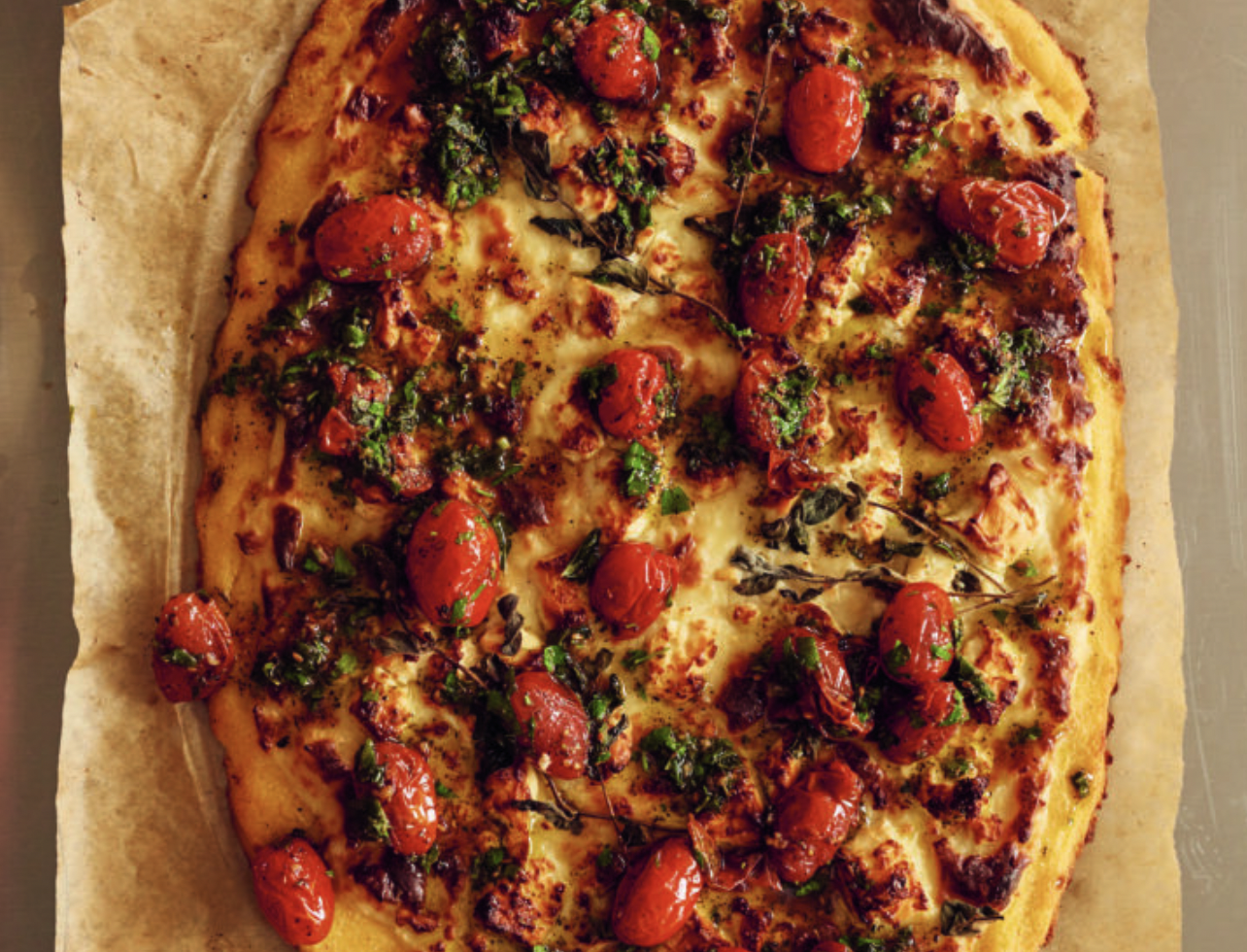
Polenta, Pizza, Polenta-Pizza, Polizza, or Polenta Not-A-Pizza?
Yotam Ottolenghi and Noor Murad Put a Twist on Classic Baked Polenta
It’s not a pizza, insisted Noor, when referring to this baked polenta, which does in fact look like a giant pizza. It ended up with multiple names at the test kitchen such as: polenta-pizza, polizza, or polenta not-a-pizza. It really is a happy-looking pie, with its yellows and reds and wonderfully golden edges. Serve with the endive salad or anything leafy and green. You can keep this gluten-free by swapping out the flour for gluten-free flour, if you like.
*
Baked polenta with feta, béchamel, and za’atar tomatoes
Serves 4 to 6, prep time: 15 minutes
Cook time: 1 hour 30 minutes

6 tbsp/80g unsalted butter
6 tbsp/50g all-purpose flour
3 1/4 cups/750ml whole milk
4 garlic cloves, peeled and minced
1 1/4 cups/300ml water
1 1/4 cups/200g quick-cook polenta
21/3 oz/65g pecorino romano, roughly grated (2/3 cup)
61/3 oz/180g Greek feta, roughly crumbled
1/4 oz/5g oregano sprigs (try to use the softer sprigs)
Za’atar Tomatoes
14 oz/400g datterini or cherry tomatoes
1/2 cup/120ml olive oil
1½ tbsp balsamic vinegar
2 garlic cloves, peeled and minced
2 tbsp za’atar
½ tsp sugar
1/4 cup/5g parsley, roughly chopped
1/4 cup/5g oregano leaves, roughly chopped
salt and black pepper
1. Preheat the oven to 350°F.
2. Make the za’atar tomatoes. Put the tomatoes, oil, vinegar, garlic, ½ teaspoon of salt, and a good grind of pepper into a medium baking dish, roughly 12 x 8 inches/30 x 20cm. Cover tightly with foil and bake for 40–45 minutes, stirring halfway through, or until the tomatoes have just burst but aren’t completely falling apart. Remove the foil, gently stir in the za’atar and sugar, and let cool completely. Once cool, stir in the herbs (gently, so as not to break up the tomatoes).
3. Turn the heat up to 475°F. Line a large baking sheet roughly 16 x 12 inches/40 x 30cm in size with parchment paper.
4. Put half the butter into a medium saucepan over medium-high heat. Once melted, add the flour and cook, whisking continuously, for 30 seconds or until it smells like popcorn. Slowly pour in 11/2 cups/360ml of the milk, whisking continuously to avoid any lumps, then add the garlic, ½ teaspoon of salt, and plenty of pepper, turn the heat down to medium, and cook for 5 minutes, stirring often, until quite thick and no longer floury-tasting. Set aside and cover with a piece of parchment paper, to prevent a skin from forming.
5. Meanwhile, prepare the polenta by first putting the remaining 12/3 cups/400ml of milk, the water, 11/2 tablespoons of the butter, 1¼ teaspoons of salt, and a good grind of pepper into a medium sauté pan (or saucepan) over medium-high heat. Once it gently bubbles, turn the heat down to medium-low, slowly add the polenta, whisking continuously to incorporate, and cook for 2 minutes, to thicken. Add the pecorino and the remaining 11/2 tablespoons of butter and stir with a spatula until incorporated. Quickly transfer to the prepared baking sheet and spread out in a large oblong shape about 1/2 inch/1cm thick and 15 inches/38cm in length. Spoon the béchamel over the top and spread it so it covers the surface, leaving a 1/2-inch/1½cm rim exposed around the edges. Top evenly with the feta and the oregano sprigs and bake for 22 minutes, or until golden and bubbling on top and starting to brown around the edges. Let cool for 5–10 minutes.
6. Spoon about half the za’atar tomatoes on top of the baked polenta, serving the rest in a bowl alongside. Use a pizza cutter to easily cut the polenta into slabs and serve warm.
_____________________________________

Excerpted from Ottolenghi Test Kitchen: Extra Good Things by Yotam Ottolenghi and Noor Murad. Copyright © 2022. Photographs copyright © 2022 by Elena Heatherwick. Published by Clarkson Potter, an imprint of Random House, a division of Penguin Random House, LLC.
Yotam Ottolenghi and Noor Murad
Yotam Ottolenghi is a seven-time New York Times best-selling cookbook author who contributes to the New York Times Food section and has a weekly column in The Guardian. His Ottolenghi Simple was selected as a best book of the year by NPR and the New York Times; Jerusalem, written with Sami Tamimi, was awarded Cookbook of the Year by the International Association of Culinary Professionals and named Best International Cookbook by the James Beard Foundation. He lives in London, where he co-owns an eponymous group of restaurants and the fine-dining destinations Nopi and Rovi.
Noor Murad is a Bahraini-born chef whose international work experience eventually brought her to the Ottolenghi family in 2016. She developed recipes for the books Falastin and Ottolenghi Flavor, as well as for Ottolenghi’s MasterClass series and other online Ottolenghi publications. Her Bahraini roots have a strong influence on her cooking, with Arabic, Persian, and Indian flavors making a prominent appearance in her recipes.












